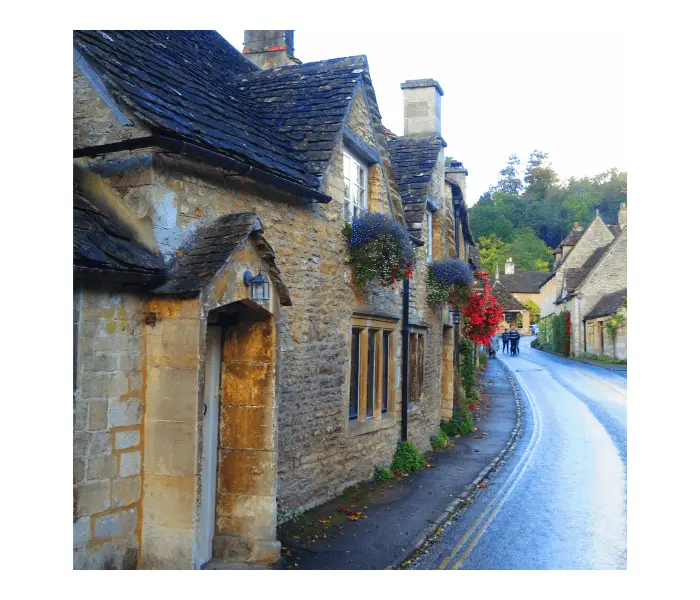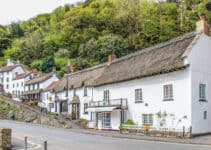When asking what is the difference between a village and a town, the main difference between a village and a town is that a town generally has a greater land area and a larger population than a village.
However, this is not always the case, and there are many other features that distinguish the two from each other.
Places that have people living in them come under the heading of “settlements”. The smallest of these is the hamlet and the largest is the city. The village and the town come in between these two, and often have their similarities, such as pubs, shops, primary schools, churches and – of course – houses.
But what makes them different? Keep reading to find out.
What Is The Difference Between Village & Town?
The difference between a town and a village are in the following ways:
- Size and population
- Purpose
- Services and facilities
- Access and transport
What is Considered a Village?
As previously mentioned, villages are usually smaller than towns and have less people living in them. Because a lot of villages originated as small farming communities, they are often to be found in relatively rural locations, meaning that they are perceived as “quieter” like the countryside, with less going on.

The government classification categorises towns and villages as such, based on their population rather than their size. A village is any settlement housing less than 7,500 residents (with hamlets also falling into this section but lacking other features of a village).
Size and Population
Anywhere that’s home to more than 7,500, but less than 175,000 people is categorised as either a small, medium or large town. Warrington and Hemel Hempstead are named as examples of large towns.
A population of more than 175,000 is the point at which a large town becomes a city.
It’s worth mentioning that the population of some towns and villages increases dramatically at certain times of the year.
This is normally down to their popularity with tourists. An example of this is Newquay in Cornwall. This world-famous town has a population of just over 20,000, but this grows to over 100,000 during the summer months.
Purpose
Interestingly, the history of the village being a farming community means that lots of villages are to be found close to natural water sources, such as springs and streams.
This makes sense, as free access to water would have been very handy when tending to crops and animals. Before mains water, there would have been a communal village well.
Where villages grew from rural farming settlements, towns historically had a different purpose. Traditionally, any settlement that was legally allowed to hold a market or a fair was classed as a town.
This naturally made towns more economically important than villages, with more opportunities to buy, sell, work and play.
Many towns are busy and filled with hustle and bustle because they usually have a central purpose, such as a port town or a market town.
The original purpose is still reflected in the names of some towns, such as Ashdon in Essex, Ellesmere Port or Chilham in Kent.

Towns may sometimes be built around a specific industry, either historically or up to the present day. They may have grown around such things as the wool trade, the coal mining industry or the manufacture of pottery, to name but a few.
Access and Transport
A town will usually be connected by good transport links. It will very often have a bus station, a train station or both.
There could be access to a nearby motorway or a main road, meaning town residents have even more options for work or leisure in towns and cities further afield.
Villages are normally more remote and secluded, which is preferred by many who live in them.
What Does a Village Have?
Villages normally have at least the bare essentials when it comes to services and facilities, and this is what sets them apart from hamlets.
For example, a stereotypical village will contain a meeting place (usually a village hall), a small shop, a primary school, a church and at least one pub.
Village fetes are a popular local activity, where games take place to bring the community together.
Towns have multiple shops, sometimes in a dedicated shopping centre. There will be a choice of schools, with at least one secondary school, servicing not only the town but also its surrounding villages.
There could even be a local college offering further education. Universities tend to be reserved for cities.
Towns normally feature leisure facilities that villages don’t have, like a swimming pool, a cinema and a nightclub or two. This applies particularly to bigger towns, or those that are popular with tourists and can be classed as resorts.
Residents of towns tend to have easier access to things like public libraries, police stations, fire stations and doctor’s surgeries. A larger town might have its own hospital.
All of these additional facilities mean that towns offer many more employment opportunities, and village residents will very often work in a nearby town.

Can A Village Be In A Town?
A village can definitely be in a town because villages will usually fall under the umbrella of a town when it comes to things like local laws and council rules.
Each town tends to have its main, central area, plus a few local villages which are classed as part of it. These villages might be miles away but will still be governed by the same council.
A town normally (but not always) has its own mayor and councillors, based in the town hall. It’s the duty of these officials to provide and maintain public services and facilities. They are, in turn, governed by the county council.
A village will almost always “belong” to a particular town. Villages are very often to be found on the outskirts of towns, sometimes making it hard to differentiate between the two.
When Does A Village Become a Town?
Every town started off life as a hamlet. Once that hamlet had more than a handful of houses, it would have needed facilities like a village shop, a place of worship, a school and a pub.
At this point, it would have become a village. In fact, the establishment of a church is traditionally the point at which a hamlet evolves into a village.
Some villages stayed that way, but some expanded further, eventually being classified as towns. As previously mentioned, a village has 7,500 residents or fewer.
If the population goes over that, the government counts it as a town (unless it’s a temporary boom in population because of the tourist season).
A village that becomes a town would not necessarily have to form its own town council. It’s common for several towns to share a borough council, which has its headquarters in just one of those towns.
This means that, with the building of many new housing estates in rural locations, it’s likely that we will see an increase in the number of villages that grow into towns.
There are some villages that could be classified as towns already, as they have the population to warrant this. One example of this is Rawmarsh in South Yorkshire, with a population of over 13,000, but there are many other larger settlements that cling to the title of “village”.
This may be because it’s often considered more desirable in this day and age to live in a village, rather than a town or a city.
Therefore it can be seen there can be a difference between what the government deems technically makes a village a village in the UK, versus what the place’s residents wish to have their community known as.
Difference Between Town and Village
So now you know what is the difference between a village and a town. The difference between villages vs towns are that villages offer a tranquil and close-knit environment, where residents can enjoy a slower pace of life and a stronger sense of community.
Towns provide better access to modern amenities, job opportunities, and diverse social networks. As urbanization shapes our world, it’s crucial to recognise the unique benefits of each lifestyle and preserve the distinct character of both towns vs village.

